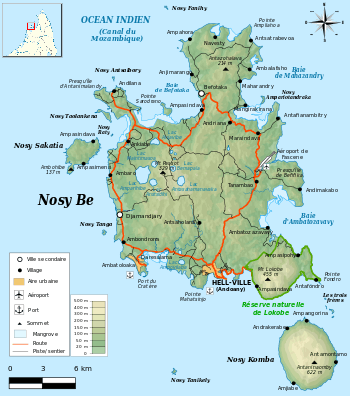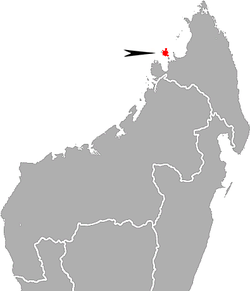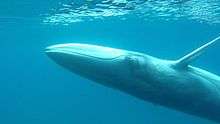Nosy Be
Nosy Be [ˌnusʲ ˈbe] (formerly Nossi-bé and Nosse Be) is an island off the northwest coast of Madagascar. Nosy Be is Madagascar's largest and busiest tourist resort. It has an area of 320.02 square kilometres (123.56 sq mi), and its population was officially estimated at 73,010 in 2013.


Nosy Be means "big island" in the Malagasy language. The island was called Assada during the early colonial era of the 17th century. Nosy Be has been given several nicknames over the centuries, including "Nosy Manitra" (the scented island).
History
The first human inhabitants of Nosy Be were small bands of Antankarana and Zafinofotsy, before the Sakalava migrated there and became the most numerous ethnic group on the island. These people were joined later by some Comorians, Indians or Antandroy.
Nosy Be made first major appearance in Madagascar's history when King Radama I announced that he intended to conquer the whole west of the red island up to the sea. That plan was eventually achieved when the Sakalava Kingdom of Boina came into his possession in 1837 when Queen Tsiomeko's army was defeated. The French colonized the island from 1840, founding an outpost named Hell-Ville (from French Admiral de Hell).[1] In 1849, slavery was abolished by the French, though the slaves were owned by Malagasies. It caused a Malagasy revolt against the French.[2] In the late 19th and early 20th centuries, the island was governed by the French as an internal protectorate within the colony of Madagascar. The French used both military force and diplomacy to maintain their position in the island, appointing the former ruler of Nosy Be Binao as the gouverneur principal of the island.[3] Though it was difficult for the French to control the littoral, they founded a plantation colony in Nosy Be, mainly producing sugar and cash crops.[4] During the Russo-Japanese War Nosy Be became a supply station for Russia's Second Pacific Squadron. The main fleet led by Admiral Zinovy Rozhestvensky reached Nosy Be on January 9, 1905, where it met a smaller detachment led by Admiral Dmitry von Fölkersam that had arrived already on December 28, 1904.[5] The fleet stayed for two months for refurbishing and coaling, leaving on March 17 to meet its fate ten weeks later at the Battle of Tsushima.[6]
Lynching of tourists, 2013
The island, like most of Madagascar, suffers from an extreme level of uncertainty linked to crime and violence. Rumours quickly turn into accusations in Madagascar, and lynchings are common, even for allegations related to traffic accidents or theft. On October 3, 2013, the body of an 8-year-old boy was discovered at the beach of Ambatoloaka on the island. The condition of the body was poor after one week in the water, and a rumour was spread that the child had been murdered by Western organ-trafficking tourists. The uncle of the boy, a local named Zaidou, was detained by the local police for questioning, but a violent mob gathered to storm the local jail to punish the supposed murderer.[7]
As the uncle was not found, the anger of the mob turned to the Westerners having been in contact with the person, French tourists Sébastien Judalet and Roberto Gianfalla. Judalet was found and dragged from his hotel to the beach of Ambatoloaka, where the large mob repeatedly hit him with sticks and stones. The police received at least five calls from bystanders or expatriates but did not respond. Two police officers actually joined the mob, one of which who was filming the lynching on his smartphone.[8] After three hours of torture and humiliation, the naked and bleeding tourists were put into car tires and thrown alive into a bonfire on the beach.[7] On the afternoon of October 3, 2013, the uncle Zaidou was found driving on the island. A mob of several hundred quickly lynched him by burning him alive on a public street next to a mosque.
Both events were filmed by the bystanders, publishing the murders on the internet. In spite of this mass of evidence, the local justice took two years of investigation to finally convict 4 members of the mob to lifetime imprisonment and 6 others to shorter sentences; 26 suspects in custody were released without charge as well as the two police officers.[9] A local politician, Joseph Yoland, was accused of inciting the killings on his radio station at the island, but the charges were dropped when the court allegedly was unable to retrieve any recordings of the aired shows that evening.[10] Following the events, the French authorities warned travellers for "high risk of assaults, that could be extremely violent",[11] U.S. travellers are also advised "[to] be aware of the potential for mob violence and ‘popular justice’ that is sometimes directed towards foreign nationals.".[12] The lynching in Nosy Be is a rare public murder of expatriates in Madagascar; most lynchings concern locals. However, expatriates are frequently subject to kidnapping and extortion, such as the January 2015 kidnapping of a 12-year old French child outside of his school,[13] and two separate kidnappings of French citizens of Indo-Pakistani origin in April 2016 that triggered the intervention of the French police tactical unit GIGN in Madagascar.[14]
Geography
Nosy Be is located about eight kilometers (5.0 miles) from the coast of Madagascar in the Mozambique Channel; several smaller islands are located nearby, including Nosy Komba, Nosy Mitsio, Nosy Sakatia, and Nosy Tanikely. The island's main town is Andoany.
The volcanic island has an area of about 312 square kilometres (120 sq mi), and its highest peak is Mont Lokobe at 450 metres (1,480 feet); the volcano is of Holocene origin but has not erupted in recorded history.[15] There are eleven volcanic crater lakes on the island.
The island is known for having one of the world's smallest frogs[16] (Stumpffia pygmaea) and chameleon (Brookesia minima).[17] The Lokobe Reserve is one of Madagascar's five Strict Nature Reserves (Réserves Naturelles Intégrales). Nosy Be is also home to a specific color of panther chameleon (Furcifer pardalis).
Omura's whale

Recent studies indicate that adjacent waters around the channel between Nosy Be[18] and Madagascar host a habitat for notable number of Omura's whale, and this has allowed researchers to conduct field studies targeting this rare species for the first time.[19][20]
Climate
Nosy Be has a tropical monsoon climate. It is most humid in summer (December, January, February). The Tsaratanana massif partially protects the island from the strong north-east winds affecting the region in August or during tropical depressions. The wet season lasts from October until the beginning of May, followed by a relatively short dry season that lasts through September. As characteristic of its climate however, it still sees moderate amounts of precipitation even during this time. Daytime temperatures remain fairly steady throughout the year, hovering around 30°C (86 °F), while the nights are slightly cooler during the dry season.
| Climate data for Nosy Be | |||||||||||||
|---|---|---|---|---|---|---|---|---|---|---|---|---|---|
| Month | Jan | Feb | Mar | Apr | May | Jun | Jul | Aug | Sep | Oct | Nov | Dec | Year |
| Average high °C (°F) | 31.1 (88.0) |
31.1 (88.0) |
31.8 (89.2) |
32.0 (89.6) |
31.2 (88.2) |
30.0 (86.0) |
29.6 (85.3) |
29.9 (85.8) |
31.0 (87.8) |
32.0 (89.6) |
32.0 (89.6) |
31.5 (88.7) |
31.1 (88.0) |
| Daily mean °C (°F) | 26.2 (79.2) |
26.3 (79.3) |
27.6 (81.7) |
26.5 (79.7) |
25.2 (77.4) |
23.1 (73.6) |
22.3 (72.1) |
23.3 (73.9) |
24.4 (75.9) |
25.7 (78.3) |
26.4 (79.5) |
26.5 (79.7) |
25.3 (77.5) |
| Average low °C (°F) | 22.6 (72.7) |
22.8 (73.0) |
22.8 (73.0) |
22.4 (72.3) |
20.9 (69.6) |
19.0 (66.2) |
18.0 (64.4) |
17.8 (64.0) |
19.1 (66.4) |
20.8 (69.4) |
22.0 (71.6) |
22.5 (72.5) |
20.9 (69.6) |
| Average rainfall mm (inches) | 518.5 (20.41) |
435.9 (17.16) |
294.7 (11.60) |
156.5 (6.16) |
61.1 (2.41) |
44.3 (1.74) |
37.4 (1.47) |
36.2 (1.43) |
39.3 (1.55) |
84.6 (3.33) |
148.1 (5.83) |
371.6 (14.63) |
2,228.2 (87.72) |
| Average precipitation days (≥ 1.0 mm) | 21 | 20 | 18 | 12 | 6 | 6 | 5 | 5 | 6 | 7 | 13 | 18 | 137 |
| Mean monthly sunshine hours | 187.0 | 171.2 | 224.0 | 245.0 | 271.3 | 248.9 | 263.7 | 284.9 | 277.6 | 281.1 | 249.1 | 219.7 | 2,923.5 |
| Source: NOAA[21] | |||||||||||||
Administration
The island constitutes a department within Diana Region and is organized as the City of Nosy Be (Commune Urbaine de Nosy Be). Its mayor is Mr. Ali Aboudou.
Economy
Once a major location of plantation of sugar cane and production of its derived products (sugar, rum), the island's main activities are now the plantation of ylang-ylang (for the production of essential oils) and tourism. Nosy Be is the most developed tourism destination in Madagascar. This is the only place in Madagascar where all-inclusive large resorts can be found.
Transportation
The island is served by Fascene Airport. The airport is serviced by commercial flights with Air Madagascar, Air Austral, Ewa, Ethiopian Airlines, and has direct flights from Europe on Neos. Its main city and harbour, Hell-Ville, can be reached by boat from Ankify.
See also
References
- Sanchez SF, « Commerce régional et à longue distance dans l'ouest de Madagascar au XIXème siècle », in Tsingy Revue de l’association des professeurs d’histoire et de géographie de Madagascar, n°9 « Les sociétés de l’océan Indien et la mer », 2008, p.44-56https://www.academia.edu/5626088/_Commerce_r%C3%A9gional_et_%C3%A0_longue_distance_dans_louest_de_Madagascar_au_XIX%C3%A8me_si%C3%A8cle_in_Tsingy_Revue_de_l_association_des_professeurs_d_histoire_et_de_g%C3%A9ographie_de_Madagascar_n_9_Les_soci%C3%A9t%C3%A9s_de_l_oc%C3%A9an_Indien_et_la_mer_2008_p.44-56
- « Sanchez S. F., Un mouvement antiabolitionniste et anticolonial : La révolte sakalava de 1849 dans le Nord-Ouest de Madagascar », in Ballarin M.-P., Derat M.-L., Médard H., Vernet T. (dir.), Traite et esclavage en Afrique Orientale et dans l’Océan Indien, Paris, Karthala, 2013, p.413-439
- Allen, Philip M.; Covell, Maureen (2005). Historical dictionary of Madagascar (2nd ed.). Lanham, Md. [u.a.]: Scarecrow Press. ISBN 978-0-8108-4636-4.
- « Sanchez S. F., "Persuasion, escarmouches, prises d’otages. L’exercice du pouvoir dans la colonie française de Nosy Be, Nord-Ouest de Madagascar (1839-1896)", in Chanson-Jabeur Ch., Morlat P., Forest A., Colonisations et Répressions, Paris, Les Indes Savantes, 2015, p.413-439
- Pierre Van de Boogaerde (2009). Shipwrecks of Madagascar. Strategic Book Publishing. p. 243. ISBN 978-1-60693-494-4.
- Alistair Horne (2015). Hubris. The Tragedy of War in the Twentieth Century. HarperCollins. p. 74ff. ISBN 978-0-06-239780-5.
- "A Madagascar, la folle rumeur qui a mené trois hommes sur le bûcher". Le Monde.fr. Retrieved 23 April 2018.
- "Foule en furie - Deux hommes lynchés à mort à Madagascar". parismatch.com. Retrieved 23 April 2018.
- "Madagascar : quatre personnes condamnées aux travaux forcés à perpétuité pour le lynchage de Nosy Be". Le Monde.fr. 2015-10-09. Retrieved 23 April 2018.
- "Madagascar - Deux Français avaient été battus à mort le 3 octobre 2013 : Lynchage de Nosy Be : un massacre lié au commerce de pierres précieuses". ipreunion.com. 23 February 2015. Retrieved 23 April 2018.
- "Madagascar- Sécurité". France Diplomatie : : Ministère de l'Europe et des Affaires étrangères. Retrieved 23 April 2018.
- "Madagascar". travel.state.gov. Retrieved 23 April 2018.
- "Un Français de 12 ans kidnappé devant son collège à Madagascar". www.europe1.fr. Retrieved 23 April 2018.
- "Kidnapping des karana, le Groupe d'intervention de la Gendarmerie nationale (GIGN) française débarque". wordpress.com. 21 April 2016. Retrieved 23 April 2018.
- "Nosy-Be". Global Volcanism Program. Smithsonian Institution.
- Stumpffia pygmaea
- Tim Flannery and Peter Schouten, Astonishing Animals: Extraordinary Creatures and the Fantastic Worlds They Inhabit. New York: Atlantic Monthly Press, 2004. Page 126-127.
- Sakalav Diving (2012). "petit rorqual minke whale.avi". YouTube. Retrieved 2015-10-25.
- Jefferson, Thomas, Marc A. Webber, and Robert L. Pitman (2015). Marine Mammals of the World: A Comprehensive Guide to their Identification. London: Academic.
- Cerchio S., Andrianantenaina B., Lindsay A., Rekdahl M., Andrianarivelo N., Rasoloarijao T. (2015). "Omura's whales (Balaenoptera omurai) off northwest Madagascar: ecology, behaviour and conservation needs". Royal Society Open Science. 2 (10): 150301. Bibcode:2015RSOS....240301C. doi:10.1098/rsos.150301. PMC 4632516. PMID 26587244.CS1 maint: uses authors parameter (link)
- "Nosy Be/Fascene Climate Normals 1961–1990". National Oceanic and Atmospheric Administration. Retrieved October 19, 2015.
- "École primaire française Lamartine." AEFE. Retrieved on May 7, 2015.
- Vacca, Maria Luisa. "Comune di Napoli -Gemellaggi" [Naples - Twin Towns]. Comune di Napoli (in Italian). Archived from the original on 2013-07-22. Retrieved 2013-08-08.
External links
| Wikimedia Commons has media related to Nosy Be. |
| Wikivoyage has a travel guide for Nosy Be. |
